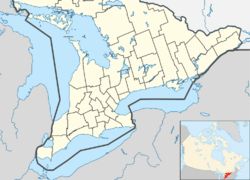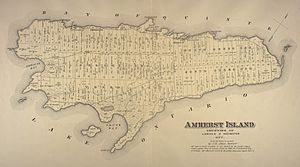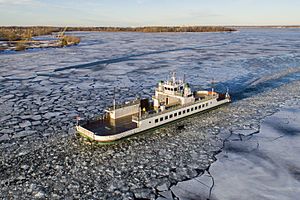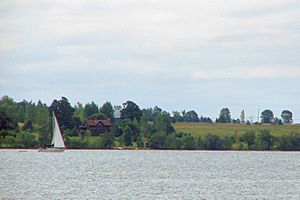Amherst Island facts for kids
 |
|
| Geography | |
|---|---|
| Location | Lake Ontario |
| Coordinates | 44°09′00″N 76°43′12″W / 44.15000°N 76.72000°W |
| Area | 70 km2 (27 sq mi) |
| Length | 20 km (12 mi) |
| Width | 7 km (4.3 mi) |
| Administration | |
|
Canada
|
|
| Province | Ontario |
| County | Lennox and Addington |
| Township | Loyalist township |
| Demographics | |
| Population | 450 |
| Pop. density | 6.43 /km2 (16.65 /sq mi) |
Amherst Island is a large island located in Lake Ontario, about 10 kilometers (6 miles) west of Kingston, Ontario, Canada. It's part of Loyalist Township in Lennox and Addington County.
The island is about 3 kilometers (2 miles) from the mainland. You can reach it by a public ferry from Millhaven. Amherst Island is quite big, stretching over 20 kilometers (12 miles) long and more than 7 kilometers (4 miles) wide. It covers about 66 square kilometers (25 square miles), making it one of the largest islands in the Great Lakes.
Amherst Island is surrounded by smaller islands. These include Nut Island, Grape Island, the Brother Islands, and Salmon Island. Together, these islands cover about 66 square kilometers (25 square miles). Nut Island is the largest of these smaller islands. It is about 600 meters (2,000 feet) off the shore of Amherst Island.
Contents
Island History
Early Names and European Arrival
Long ago, Indigenous peoples visited and lived on Amherst Island during certain seasons. They called it Ka8enesgo, which means "big, long island." Later, the French knew it as Isle Tonti. This name honored Henri de Tonty, who explored the area with La Salle.
Settlement by Loyalists (people loyal to Britain during the American Revolution) began around 1792. By 1835, many people lived on the island. On July 16, 1792, John Graves Simcoe, the Lieutenant Governor of Upper Canada, officially renamed the island Amherst Island. This was to honor Jeffery Amherst, 1st Baron Amherst, a British military leader. Simcoe also renamed nearby islands, like Wolfe Island and Howe Island, after other British generals from the Seven Years' War.
Land Ownership and Irish Settlers
In 1788, the island was given to Sir John Johnson, 2nd Baronet. His family had lost their lands in New York during the American Revolution. In 1823, Sir John's daughter, Catharine Maria Bowes, took control of the island. She sold some land to avoid taxes.
Later, in 1835, Stephen Moore, 3rd Earl Mount Cashell bought the rest of the island from Mrs. Bowes. Mount Cashell wanted to create a large farming estate. He hoped to make money by having many hardworking tenants (people who rent land) clear and farm the land. He also believed he could help solve overpopulation in Ireland by encouraging people to move to Canada. He thought this would create a strong farming community and help trade between Canada and Britain.
Many Irish settlers came from the Ards Peninsula in County Down, Ireland. Their homeland had many windmills because it was windy and lacked water power. Mount Cashell gave these settlers leases for seven years with low rent. They had to make improvements to the land each year. He also built two piers for harbors, brought in a clergyman for St James' Anglican Church, and provided a surgeon. He also built a general store and a forge.
Families from Ards started arriving in the 1820s. More friends and relatives joined them in the 1830s and 1840s. By 1841, the island had three schools and over 1,000 people. Most families were Presbyterian, with others being Roman Catholic, Church of England, or Methodist. These Irish immigrants lived in simple log houses on their rented land. They usually couldn't afford to buy their own farms.
Life was different for people on the island. Some people owned their farms (freeholders), while most were tenants who rented. Freeholders had better homes and equipment. Tenants often lived in temporary homes and couldn't plan for the long term.
By the 1840s, the island's soil was becoming less fertile. Also, a pest called the Hessian Fly appeared. Many tenant families left to find land they could own in other areas. Mount Cashell faced financial difficulties. In 1848, he had to mortgage Amherst Island. Eventually, in 1856, the island was sold to Robert Perceval Maxwell (1813-1905). Today, some island residents are descendants of those early Irish settlers.
In the mid-19th century, Amherst Island had a mixed economy. People farmed wheat and barley, fished in the Bay of Quinte, sailed the Great Lakes, and built ships. Over time, shipbuilding moved away, and railways replaced water transport. Crop farming changed to dairy farming. Those who couldn't adapt left the island.
Robert Perceval Maxwell helped the island's economy. He started an agricultural society and a cheese factory. He also helped finance loans for improvements. Many Irish immigrants became landowners and held important positions. The island became known for its strong Irish heritage. For example, John Watson, from Portaferry, named his pub the 'County Down Inn'. The stone fences on the island were built like those in Ards.
By the 1870s, the remaining tenants could finally buy their farms. They started building better homes. This led to the island likely importing coal for heating around 1880.
Amherst Island Virtual War Memorial
This section remembers the islanders who served and died in wars.
Boer War
- Corporal Edward Allan Filson †
World War I
- Lieutenant Bertram Kerr Allen †
- Sapper James Henry Bell †
- Private Charles Burgess †
- Private James Ernest Arthur Dennee †
- Private Frederick C Morris Glass †
- Private Thomas Edward McFern †
- Private Edward Alexander Milligan †
- Private Hugh Sterling Polley †
- Private William Ross Pringle †
- Trooper Charles Reid †
- Private Bernard George Twort †
- Lance Corporal Lawrence Oswald K Wemp †
- Private Frederick Willard †
World War II
- Flying Officer John James Earls †
- Corporal John Henry Kearney †
- Warrant Officer Wallace David Kearney †
- Flying Officer Anthony Brian Orchard †
- Pilot Officer Cecil Ralph Tait †
- Gunner Fred Ernest Wemp †
Island Community
Amherst Island has two main communities: Stella and Emerald. Stella, once called Lower Landing, is where the ferry docks. It has a general store, a restaurant called the Back Kitchen, a museum, and an art studio. Emerald, once Upper Landing, is a smaller group of houses and a church further west.
You can only reach the island by water or air. A ferry service connects Stella on the island with Millhaven on the mainland. The ferry, called M/V Frontenac II, runs every day of the year. The trip takes about 20 minutes. There's a small fee for bikes and motorcycles, but walking on is free. The ferry service is run by Loyalist Township.
About 450 people live on Amherst Island year-round. This number doubles during the summer months. The Amherst Island Community Centre is open when school is not in session.
The Ministry of Transportation is improving the ferry docks. They are changing the ramps to make it easier for vehicles to get on and off. They are also building new waiting areas and restrooms. A new ferry is also planned to replace the M/V Frontenac II around 2019.
Amherst Island Radio 92.1 FM
Amherst Island has its own volunteer community radio station, Amherst Island Radio CJAI. It started broadcasting on April 1, 2006. The station is run entirely by volunteers. It focuses on preserving the island's way of life, sharing local news, and promoting Canadian music.
Notable Islanders
Some famous people have lived on Amherst Island. Harry Raymond Fleming (1892–1942) was born on the island and later became a Canadian Member of Parliament for Humboldt, Saskatchewan.
English-born artist Daniel Fowler (1810–94) moved to Amherst Island in 1843 and lived there until he died. He loved the island's natural beauty and found many subjects for his art there. Daniel Fowler is considered one of the "fathers of Canadian Art." The house where he lived is still on the north shore of the island, and a plaque marks the spot.
Island Nature and Wildlife
Long ago, Amherst Island was covered in a thick, mixed forest. It had trees like sugar maple, beech, and oak. This forest was very old and rarely had fires. Today, most of that forest is gone, replaced by grasslands due to centuries of farming. The soil is now heavy white clay. The island faces challenges like summer droughts and strong winter winds, which make it hard for young trees to grow. Animals like meadow voles and white-tailed deer also threaten young trees. The Emerald ash borer is also a threat to the island's ash trees.
Amherst Island is famous around the world for its many hawks and owls in winter. It's home to the well-known Owl Woods nature reserve. Sometimes, up to 10 different types of owls can be seen in one winter! You might spot short-eared owls, long-eared owls, and great horned owls. Owls from the far north, like snowy owls, saw-whet owls, and the rare boreal owl, also visit in late fall and winter. Eastern screech owls and barred owls are also present. You can also see red-tailed hawks and rough-legged hawks, and sometimes even bald eagles, peregrine falcons, and turkey vultures.
The island is also an Important Bird Area because many birds migrate through it. This has caused some concern about plans to build wind turbines on the island.
Farming is important on Amherst Island, especially sheep farming. There are thousands of sheep on the island. The island's roads have little traffic, making it a great place for cycling, especially on the gravel roads along the shores. The island has warm summers, cold winters, and steady winds from the lake most of the year.
A report called "Islands of Life" in 2010 ranked Amherst Island second in terms of how many different types of plants and animals it has among the islands of northeast Lake Ontario. Only Wolfe Island has more. Amherst Island is also listed in "100 Nature Hot Spots in Ontario," a book published in 2016.
Dry Stone Walls
Amherst Island has the largest collection of historic Irish dry stone walls in Canada. These walls are built without any mortar, just carefully stacked stones. Many of them are thought to be at least 160 years old or even older. The Dry Stone Walling Association of Canada believes these walls are a special part of the island's history.





